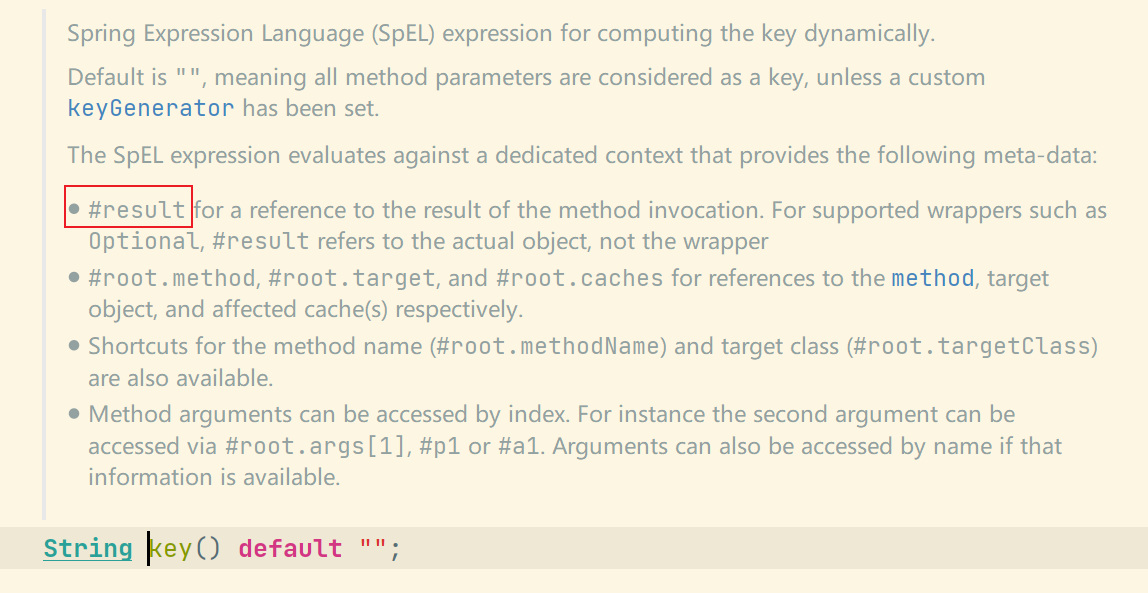使用SpringCache操作Redis缓存数据
发布时间:2024年01月11日
SpringCache概念
SpringCache是一个框架,实现了基于注解的缓存功能,只需要简单的加一个注解,就能实现缓存功能。
SpringCache提供了一层抽象,底层可以切换不同的缓存实现,例如:
- EHCache
- Caffeine
- Redis
使用(导入redis跟SpringCache的 依赖即可)
<dependency>
<groupId>org.springframework.boot</groupId>
<artifactId>spring-boot-starter-data-redis</artifactId>
</dependency>
<dependency>
<groupId>org.springframework.boot</groupId>
<artifactId>spring-boot-starter-cache</artifactId>
</dependency>SpringCache常用注解
| @EnableCaching | 开启缓存注解功能,加在启动类上 |
| @Cacheable | 加在方法上,执行方法前会先去缓存中查看是否有缓存有的话直接返回,没有的话会通过反射调用方法,并将方法的返回值缓存起来 |
| @CachPut | 将方法的返回值,直接放在缓存中 |
| @CacheEvict | 将一条数据或者多条数据从缓存中删除 |
@Cacheable使用
@GetMapping("/test")
@Cacheable(value = "test",key = "#key",unless = "#result == null") //组合起来的key就是test:: + 入参key
public String test(String key) {
return "hello SpringCache";
}如果入参是对象:
@GetMapping("/test")
@Cacheable(value = "test",key = "#user.id",unless = "#result == null") //组合起来的key就是test:: + 入参user的id属性
public String test(User user) {
return "hello SpringCache";
}unless
unless的意思就是: 当不满足条件的时候进行缓存 也就是condition 相反,因为condition中没有#result这个spel表达式,所以要使用unless
底层知识:
Cacheable底层是通过代理来实现的,当你调用的时候创建一个Controller的代理对象,会先拼接key,判断在缓存中是否存在,存在直接返回,不存在通过反射调用方法。如果返回值满足指定条件(condition、unless)会将返回值缓存起来。
@CachePut 使用
CachePut会将返回值放到缓存中,unless跟condition跟Cacheable一样
还有一个不同就是Cacheable的key没有#result这个表达式,CachePut有
可以看一下CachePut源码的注释:

@GetMapping("/test3")
@CachePut(value = "test3",key = "#key")
public List<String > test3(String key) {
List<String > list = new ArrayList<>();
list.add("1");
list.add("1");
list.add("1");
list.add("1");
return list;
}@CacheEvict 使用
精准删除(test4::key)
@GetMapping("/test4")
@CacheEvict(value = "test4",key = "#key")
public List<String > test4(String key) {
return null;
}
全部删除(test4::)
@GetMapping("/test4")
@CacheEvict(value = "test4",allEntries = true)
public List<String > test4(String key) {
return null;
}
文章来源:https://blog.csdn.net/weixin_65861329/article/details/135515869
本文来自互联网用户投稿,该文观点仅代表作者本人,不代表本站立场。本站仅提供信息存储空间服务,不拥有所有权,不承担相关法律责任。 如若内容造成侵权/违法违规/事实不符,请联系我的编程经验分享网邮箱:chenni525@qq.com进行投诉反馈,一经查实,立即删除!
本文来自互联网用户投稿,该文观点仅代表作者本人,不代表本站立场。本站仅提供信息存储空间服务,不拥有所有权,不承担相关法律责任。 如若内容造成侵权/违法违规/事实不符,请联系我的编程经验分享网邮箱:chenni525@qq.com进行投诉反馈,一经查实,立即删除!